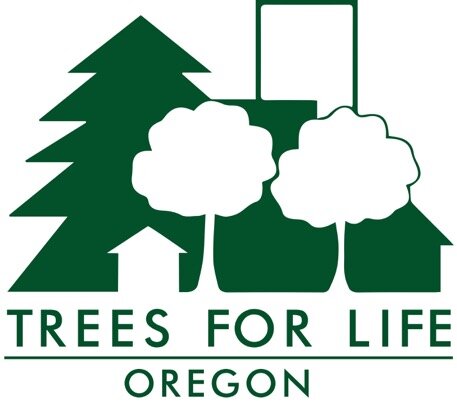More Housing, More Trees: Giving Oregonians Both
TFLO's Jim Gersbach speaking at the OCT conference on June 27, 2024.
Sorely needed conversations about the need for both more housing and more shade-giving canopy have started taking place at the state level. On June 27, Trees for Life Oregon was one of the sponsors for the nonprofit Oregon Community Trees (OCT) annual conference, in Eugene. This year’s theme was the climate and health benefits for Oregonians of designing new housing around existing and/or new large trees and how some policies, agencies, planners, and developers around the state are making this happen. OCT works with, and some of its programs are supported by, the Oregon Department of Forestry Urban and Community Forestry Program.
Some conference speaker highlights:
—Eugene’s mayor-elect, Kaarin Knudson, an architect who has co-written a book on sustainable urban design, spoke at and then stayed through the all-day conference, citing the “opportunities for repair” to create a robust urban forest as well as compact development.
—Oregon Department of Land Conservation and Development Housing Growth Management Analyst Jena Hughes referred to the causes for and negative effects of housing insecurity that, though she did not make this link, also run true for low-canopy. Housing, she said, is a climate, public health, and safety issue, and housing insecurity was fueled by historical policies and practices such as redlining, exclusionary zoning, and increased segregation. In TFLO’s view, housing insecurity and lack of canopy share these elements in common, and could be cited when advocating to integrate housing with trees.
Wilsonville Community Development Director Chris Neamtzu's "Tools for Success" conference slide.
—City of Wilsonville Community Development Director Chris Neamtzu talked about specific ways Wilsonville has gone about redeveloping large sites for residential homes while preserving individual trees and tree groves. The city planned for existing trees at the earliest stage of the process all the way through post-construction maintenance, and it “approached developers with the idea that land is not a clean slate, that every single property has inherent characteristics that are worthy of taking a look at” and incorporating into the plan. At the 200-acre Frog Pond West residential project, to address connectivity planners created pedestrian paths rather than more streets. “The regulations we use are flexible, and those standards result in negotiations and trade-offs. We will flex dimensional standards for a wide variety of things to preserve trees in order to get a better project,” said Neamtzu. His last slide showed a new house with a 50-year-old tree in front that’s “got an instant sense of place where people absolutely love to be.”
—Portland-based developer Eli Spevak of Orange Splot, LLC, whose work TFLO spotlighted a few years ago, explained how he goes about creating housing around existing trees rather than, as most developers tend to do, impose a standard concept on a site as if it were blank. He talked about where in the planning process trees “get saved or doomed,” the various tree preservation strategies he has used, and why he also plants succession trees.
One of Neamtzu's slides, Wilsonville's Frog Pond West, showing, at left, the end result of some of the preserved trees and, on right, the plan for same
—Depave Executive Director Ted Labbe spoke about how “small interventions matter in our cities,” illustrating how Depave’s work has expanded from school and church parking lots to include work on street trees and pocket parks.
—Oregon Department of Land Conservation and Development’s Community Green Infrastructure Program Administrator Laura Buhl highlighted one of the requirements of the state’s Climate-Friendly and Equitable Communities Rules—Parking Regulation Improvements. She views this as an opportunity for Oregon to use car infrastructure such as parking lots as space for trees in ways that don’t affect space for housing. She also said cities need to adjust their standards and let trees be planted closer together and closer to intersections. And she cited narrowing streets and creating street medians as ways to leave more space for trees.
—Trees for Life Oregon’s Jim Gersbach presented the case for how more space for big trees can be created in cities, citing positive examples in Portland that TFLO would like to see expanded citywide. (Here’s a short version of the points he made.)



